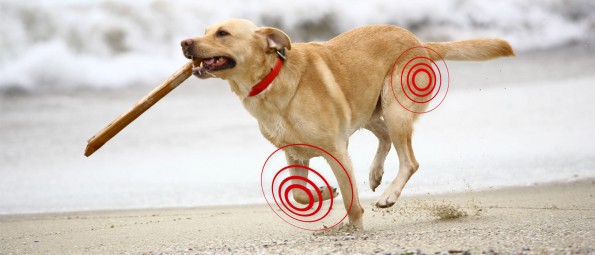
Does your pet have osteoarthritis?
What is osteoarthritis?
Osteoarthritis, also known as degenerative joint disease, is one of the most common causes of lameness in pets. Osteoarthritis is characterized by the loss of the smooth cartilage that covers and protects the end of the bones in a movable joint. When the cartilage wears away, the bone is exposed. When the two bone ends in a joint touch each other it results in pain and inflammation.
Osteoarthritis affects about 20% of dogs over 1 year of age. Some breeds of dogs, such as Labradors, Golden Retrievers, German Shepherds and Rottweiler’s are at greater risk of developing osteoarthritis than other breeds. These breeds are predisposed to abnormal conditions involving joints, bones, and muscles.
There are two main types of degenerative joint disease. Primary degenerative joint disease can occur as a result of wear and tear on an otherwise healthy joint as the pet ages. Secondary degenerative joint disease occurs as a result of another condition affecting the joint. A few examples of those conditions are congenital defects (hip or elbow dysplasia), trauma, or dislocation of the kneecap or shoulder.
What are the symptoms of osteoarthritis?
Most of the time, the first symptom dog owners report is that their dogs are doing less or having difficulty with common activities. The dog now has problems getting up on the couch, going up stairs, or getting in the back of the SUV. With more athletic dogs, maybe they can’t run as long with their owner, or they don’t want to play as long at the dog park. From there it progresses to obvious lameness such as having an unusual gait or not putting weight on the limb.
Cats are masters of hiding discomfort and pain and often do not demonstrate obvious signs that you might expect. Jumping up or down less frequently, difficulty using the litter tray, sleeping in different or easier to access sites, and reduced interaction with people are some of the signs associated with arthritis in cats.
How is Osteoarthritis diagnosed?
In most instances diagnosing osteoarthritis will require a thorough medical history, examination, radiographs, or even blood work. Sometimes a diagnosis of degenerative joint disease or osteoarthritis warrants further evaluation to determine the underlying cause of the problem such as hip dysplasia, patellar instability or any other predisposing condition.
How can you help your pet?
While there is not yet a cure for this debilitating disease, there is much you can do to control the pain, make your pet comfortable, and perhaps slow down the progression of the symptoms. There a various medical treatments to help pets manage osteoarthritis such as weight management, exercise, physical therapy, laser therapy, oral supplements, anti-inflammatory medications, and surgical procedures.
If you have questions or think your pet may be displaying signs of osteoarthritis please do not hesitate to call our hospital and speak with one of our team members.
